Advertisement |
 |
|
 |
 |
TABLE OF CONTENTS
|
November 2016 Volume 8, Issue 11 |
 |  |  |
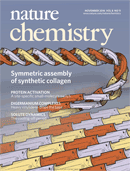 |  Editorial Editorial
 Thesis Thesis
 Corrections Corrections
 Interview Interview
 News and Views News and Views
 Review Review
 Articles Articles
 Corrigendum Corrigendum
 In Your Element In Your Element | |
 |
|
 |
 |
Advertisement |
 |
| Lithium-ion batteries are efficient energy storage devices that have transformed personal electronics. However, questions still remain as to whether they will realise their full market potential. Find out more about the key challenges facing their development here. |  | | |
 |
| |
| Advertisement |
 |
| Covering the evolution of science since 1869, Nature has a multidisciplinary global scientific network of readers. Join a community of great minds and be part of the discussion with a personal subscription from £65 (UK), $93 (US), €84 (EU). | | | |
 |
| |
Advertisement |
 |
| |
 |
| |
Editorial |  Top Top |
 |
 |
 |
Frameworks for commercial success p987
doi:10.1038/nchem.2661
Taking chemical technology from the bench to the consumer is a formidable challenge, but it is how research can ultimately benefit wider society. Companies are now beginning to incorporate metal-organic frameworks into commercial products, heralding a new era for the field. |
 |
Thesis |  Top Top |
 |
 |
 |
Slow chemistry pp988 - 989
Bruce Gibb
doi:10.1038/nchem.2652
Researchers should spend more time doing science than cataloguing every last detail about how they get it done, argues Bruce Gibb. |
 |
Corrections |  Top Top |
 |
 |
 |
Correction p989
doi:10.1038/nchem.2646 |
 |
Interview |  Top Top |
 |
 |
 |
MOFs move to market pp990 - 991
Thomas Faust
doi:10.1038/nchem.2656
Omar Farha (Chief Science Officer & technical founder) and Ben Hernandez (Chief Executive Officer) of NuMat Technologies, talk to Nature Chemistry about the release of one of the first MOF-based commercial products and the challenges the journey posed. |
 |
News and Views |  Top Top |
 |
 |
 |
|
 |
Correction |  Top Top |
 |
 |
 |
Correction p996
doi:10.1038/nchem.2667 |
 |
Review |  Top Top |
 |
 |
 |
Materials and methods for delivery of biological drugs pp997 - 1007
Alexander N. Zelikin, Carsten Ehrhardt and Anne Marie Healy
doi:10.1038/nchem.2629
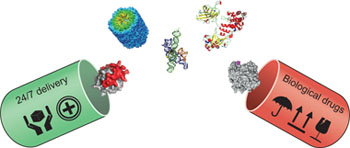
Biological drugs can offer high potency and selectivity; however, this class of therapeutics often shows poor stability upon oral administration and during subsequent circulation. This Review highlights the materials and methods used to deliver biological drugs, and discusses how these approaches can improve their pharmacokinetics. |
 |
| Advertisement |
 |
Nature Reviews Chemistry — Stay Informed
The second physical sciences title in the Nature Reviews portfolio, Nature Reviews Chemistry aims to build on the success of Nature Chemistry and emulate the principles of authoritative, high-quality content and exceptional editorial standards that are the hallmark of the Nature Reviews titles. Register for the Nature Reviews Chemistry e-alert and stay informed about the latest news and research in topics covering the breadth of pure and applied chemistry.
Sign up for the e-alert |  | | |
 |
| |
Articles |  Top Top |
 |
 |
 |
Peptide tessellation yields micrometre-scale collagen triple helices pp1008 - 1014
I. Caglar Tanrikulu, Audrey Forticaux, Song Jin and Ronald T. Raines
doi:10.1038/nchem.2556
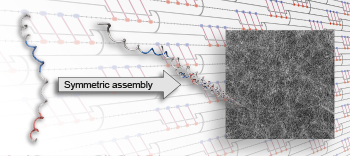
Natural collagen contains triple helices that are approximately 1,000 residues in length and cannot be formed by chemical synthesis. Now, short collagen-mimetic peptides that self-assemble into three-stranded helices have been designed. These peptides are inspired by the mathematics of tessellations, and the triple helices formed via this approach match or exceed the length of those found in natural collagen. |
 |
 |
 |
Deep-hole transfer leads to ultrafast charge migration in DNA hairpins pp1015 - 1021
Nicolas Renaud, Michelle A. Harris, Arunoday P. N. Singh, Yuri A. Berlin, Mark A. Ratner et al.
doi:10.1038/nchem.2590
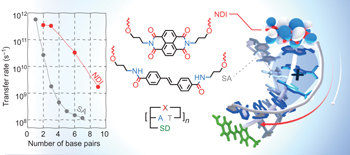
Charge transfer in DNA is of fundamental interest in chemistry and biochemistry and has possible applications in nano-electronics. Now it has been shown, through a combined experimental and theoretical study, that the migration of positive charges through low-lying orbitals of nucleobases (deep-hole transfer) leads to charge transfer that is faster than previously considered transport regimes.
See also: Article by Burton et al. |
 |
 |
 |
A stable heavier group 14 analogue of vinylidene pp1022 - 1026
Arnab Rit, Jesús Campos, Haoyu Niu and Simon Aldridge
doi:10.1038/nchem.2597

Vinylidene, (H2C=C), is a short-lived structural isomer of acetylene. By employing bulky and strongly electron-donating boryl co-ligands, the synthesis of an analogous group 14 vinylidene compound is reported. The digermavinylidene, {(HCDippN)2B}2GeGe, (where Dipp = 2,6-iPr2C6H3), is synthesized via oxidation of the corresponding symmetrical Ge0 compound K2[(boryl)GeGe(boryl)].
See also: Article by Kiyonaka et al. |
 |
 |
 |
Small-molecule control of protein function through Staudinger reduction pp1027 - 1034
Ji Luo, Qingyang Liu, Kunihiko Morihiro and Alexander Deiters
doi:10.1038/nchem.2573
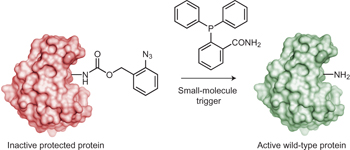
A generally applicable small-molecule switch for protein function in live cells has been developed based on selective protein protection using unnatural amino acid mutagenesis and a bioorthogonal deprotection via Staudinger reduction. |
 |
 |
 |
Total synthesis and structure–activity relationship studies of a series of selective G protein inhibitors pp1035 - 1041
Xiao-Feng Xiong, Hang Zhang, Christina R. Underwood, Kasper Harpsøe, Thomas J. Gardella et al.
doi:10.1038/nchem.2577

G proteins are the key mediators of G protein-coupled receptor signalling, facilitating a number of important physiological processes. Now, the total synthesis and structure–activity relationship studies have been reported for the only known selective Gq protein inhibitors, the natural cyclic depsipeptides YM-254890 and FR900359.
Chemical compounds |
 |
 |
 |
Translational, rotational and vibrational relaxation dynamics of a solute molecule in a non-interacting solvent pp1042 - 1046
Michael P. Grubb, Philip M. Coulter, Hugo J. B. Marroux, Balazs Hornung, Ryan S. McMullen et al.
doi:10.1038/nchem.2570
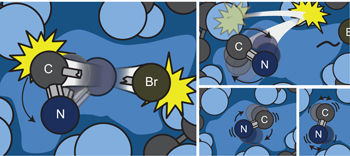
Spectral broadening generally conceals the signatures of rotational and translational motion in solution-phase spectra. Now, using highly inert perfluorocarbon solvents, spectral broadening has been minimized allowing the translational, rotational and vibrational relaxation dynamics of highly excited CN solute molecules to be observed simultaneously. |
 |
 |
 |
Fast and selective ring-opening polymerizations by alkoxides and thioureas pp1047 - 1053
Xiangyi Zhang, Gavin O. Jones, James L. Hedrick and Robert M. Waymouth
doi:10.1038/nchem.2574
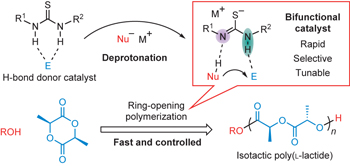
By simply deprotonating a neutral hydrogen-bond donor thiourea it is possible to generate a class of highly efficient and tunable thioimidates that can simultaneously activate a pro-nucleophile and an electrophile. These bifunctional thioimidates exhibit fast kinetics and high selectivity for ring-opening polymerizations of cyclic lactones and carbonates.
Chemical compounds |
 |
 |
 |
Nickel-centred proton reduction catalysis in a model of [NiFe] hydrogenase pp1054 - 1060
Deborah Brazzolotto, Marcello Gennari, Nicolas Queyriaux, Trevor R. Simmons, Jacques Pécaut et al.
doi:10.1038/nchem.2575
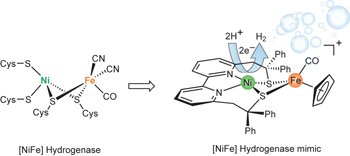
[NiFe] hydrogenases are enzymes containing nickel and iron centres that catalyse hydrogen evolution with performances that rival those of platinum catalysts. Now, a NiFe model complex has been reported that mimics the structure and the Ni-centred hydrogen evolution activity found at the active site of [NiFe] hydrogenases. |
 |
 |
 |
Observation of trapped-hole diffusion on the surfaces of CdS nanorods pp1061 - 1066
James K. Utterback, Amanda N. Grennell, Molly B. Wilker, Orion M. Pearce, Joel D. Eaves et al.
doi:10.1038/nchem.2566
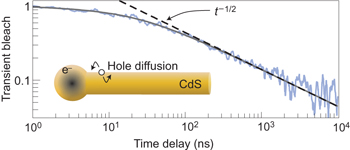
Photoexcited holes in CdS nanocrystals rapidly trap to the surface and although they are integral to nanocrystal photophysics and photochemistry, their dynamics have remained elusive. Time-resolved spectroscopy and theoretical modelling have now revealed that trapped holes in CdS nanorods are mobile and undergo a random walk on the nanocrystal surface. |
 |
 |
 |
MIDA boronates are hydrolysed fast and slow by two different mechanisms pp1067 - 1075
Jorge A. Gonzalez, O. Maduka Ogba, Gregory F. Morehouse, Nicholas Rosson, Kendall N. Houk et al.
doi:10.1038/nchem.2571
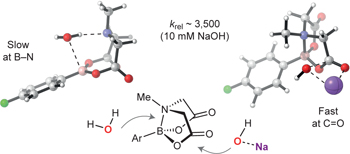
The staged hydrolysis of N-methylimidodiacetic (MIDA) boronates is a prerequisite for their application in small-molecule constructions. Mechanistic studies now show that two distinct hydrolysis mechanisms operate in parallel, the partitioning — which is dependent on the pH, water activity and homogeneity of the medium — can be readily quantified by 18O incorporation. |
 |
 |
 |
Identification of (S)-selective transaminases for the asymmetric synthesis of bulky chiral amines pp1076 - 1082
Ioannis V. Pavlidis, Martin S. Weiß, Maika Genz, Paul Spurr, Steven P. Hanlon et al.
doi:10.1038/nchem.2578
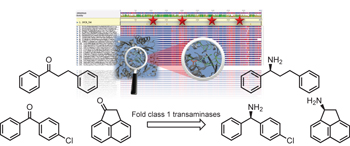
A motif was identified in the scaffold of an (S)-selective transaminase that enables the asymmetric synthesis of bulky chiral amines. This motif is transferable to other enzymes with as low as 70% sequence identity. The biocatalysts developed show high stereoselectivity and their synthetic potential was confirmed in preparative scale synthesis. |
 |
In Your Element |  Top Top |
 |
 |
 |
Active actinium p1084
Gauthier J.-P. Deblonde and Rebecca J. Abergel
doi:10.1038/nchem.2653
Naturally scarce but synthetically accessible, Gauthier J.-P. Deblonde and Rebecca J. Abergel discuss element 89 and its emergence as a candidate radio-theranostic metal for cancer treatment. |
 |
Corrigendum |  Top Top |
 |
 |
 |
Corrigendum: Dearomative dihydroxylation with arenophiles p1083
Emma H. Southgate, Jola Pospech, Junkai Fu, Daniel R. Holycross and David Sarlah
doi:10.1038/nchem.2649 |
 |
 Top Top |
 |
 |
 |
| Advertisement |
 |
npj Materials Degradation is a new open access journal that is now open for submissions. The journal publishes the finest content describing basic and applied research discoveries in the area of corrosion (degradation) and protection of materials.
Sign up for article e-alerts >>> |  | | |
 |
| |
 |  |  |  |  |  | Natureevents is a fully searchable, multi-disciplinary database designed to maximise exposure for events organisers. The contents of the Natureevents Directory are now live. The digital version is available here.
Find the latest scientific conferences, courses, meetings and symposia on natureevents.com. For event advertising opportunities across the Nature Publishing Group portfolio please contact natureevents@nature.com |  |  |  |  |  |
|
 |


No comments:
Post a Comment